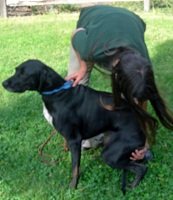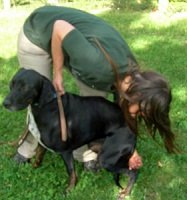

June 14, 2011 Issue #7 Published by Sue SkiffA Note From SueHow’s it going? FOUR TIPS FOR TRAINING YOUR DOG TO SITA few weeks ago, I talked about reasons for teaching your dog to sit. In this article, I will give tips what, and what not, to do, when teaching your dog to sit.Tip 1: Start teaching sit as soon as you get your dog. It doesn’t matter how young your dog is, teach it to sit on command as soon as you bring it home. This will give your dog something familiar to do whenever you need to quickly get it to calm down. Tip 2: When you first teach your dog to sit, have your dog next to you. Most people teach their dogs to sit when their dogs are facing them. I like to teach dogs to sit while they are next to me. That way, when we are walking, I can have those dogs sit next to me when we stop. Once a dog knows how to sit on command, I start telling it to sit when it is in front of me, behind me, off away from me, etc. Tip 3: Avoid teaching your dog to sit only when it sees a treat. I don’t show dogs treats until after they have done what I have told them to do. When I teach a dog to sit, I bring one hand up in front of the dog, and over its head, while using the other hand to guide the dog into a sit. Many dogs are taught to sit by having treats brought up in front of their faces, and thus learn to sit only when they see treats. This is not true training. Tip 4: Don’t push straight down on your dog’s rump. Most people try to get their dogs to sit by pushing on their dogs’ rumps. Many dogs can resist this, and will. It is far easier, although more awkward for the person, to guide your dog into a sit by placing your hand behind your dog’s knees (just below your dog’s rump, and curling your dogs legs under it. 

Once your dog is sitting regularly on command, teach it that to get things that it values, it will have to sit first. This makes teaching your dog that you are in charge much easier. Have fun with it, and soon you will be seeing your dog sitting whenever it wants something. Good luck!
IS CAT FOOD KILLING YOUR CAT? - PART 2Last week, I talked about the issues with cat food and taurine. You can argue that since pet food manufacturers quicky discovered, and remedied the taurine issue, they must be continuing to make sure that they are doing a good job of insuring cats' health. However, let’s get back to those health issues that I previously mentioned did not exist in cats before the invention of cat food. I am quite certain that there are two reasons that particular health issues are common in cats; and both of them have to do with cat food, specifically dry cat food.The first reason is that cats aren’t supposed to eat grains. Cats are strict carnivores. Their natural diet consists only of small, freshly killed animals. The only place a cat eating a natural diet gets grains is from the stomach contents of its prey. Since grain is not readily available in nature, it is going to be the rare prey item that has grains in its stomach. Yet, dry cat food is grain-based. Most canned foods also include some grains, as well. Since cats aren’t designed to eat grains, their bodies have stronger negative reactions to the starches in the grains than omnivores like humans and dogs. Many cats develop two carbohydrate related health problems from eating a diet consisting of grain-based cat food; tooth decay and diabetes, and many others become obese from the consumption of carbohydrates that they are not designed to eat. As if the above isn’t enough, there is a serious issue with dry cat food that I believe leads to kidney disease and FUS. It is the fact that dry cat food is, well, dry. Cats are designed to get most of their water from their food. Hence, they are not normally big drinkers of water. Consider the fact that an animal body is composed of 75-80% water. Therefore, if a cat is eating a small, freshly killed animal, 75-80% of what it is consuming is water. Compare the above to the negligible amount of water in dry cat food, and you can see where the problem is. Over years of eating a diet consisting of mainly (or only) dry cat food, and of drinking inadequate amounts of water to compensate for the lack of water in their food, cats stress their urinary tracts and kidneys severely. Hence, I have had pet sitting clients tell me that they know that once a cat turns 14 or so, it is pretty much bound to get kidney disease. This saddens me tremendously, because I am absolutely certain that this is totally preventable. If the above is not enough to get you to question whether it is truly in your cat’s best interest to feed it dry food, then consider the fact that dry cat food is designed to be chewed. “So what?” you ask. Well, cats have no chewing teeth in their mouths. That’s right, zero. Chewing teeth, or molars, are only found in animals designed to eat plant materials. We have plenty. Dogs have some. Cows, horses and mice have mouths full of them. Cats have none. If you don’t believe me, look in your cat’s mouth. You see? No chewing teeth. They are not designed to chew their food. Still don’t believe me? Go to your nearest zoo, and watch how a wild cat eats. You’ll see that it grabs whatever animal it is eating in the back of its mouth, gnaws off a chunk, and swallows the chunk whole. Cats don’t chew; unless their only choice for food is food that has to be chewed. So, what’s the answer? Stay tuned for my opinion.
DAY TRAININGIt’s part of life in the 21st century. You get the kids off to school, work all day, pick the kids up at daycare, make dinner, and collapse. But, what about the dog? How do you find the time to train it to be a good citizen? Maybe, you managed to get your dog into a puppy kindergarten class, and then a basic obedience class. But, you really didn’t have time to practice the way the instructor wanted you to, and now, well now, it’s all kind of fallen by the wayside.You know that your dog can do better. Perhaps, your dog has some behavior issues. Whether or not they’re serious issues, they make your life harder, don’t they? So, what do you do when you’re already stretched, and you know your dog needs more? The answer is “day training.” Day training starts with a meeting with me where you describe your dog training needs, and your dog’s behavior issues. I then come to your house for an hour or so, on agreed upon days, to train your dog. You get to get on with your life, while your dog gets training and attention from a professional. And, that training and attention is customized to your and your dog’s exact needs. Maintaining what your dog learned is also built into the day training program. At the end of each week of training, I meet with you to go over what your dog has learned, as well as what you need to do to maintain the learning. After the agreed upon number of weeks has elapsed, I return for a follow-up or two, to make sure that you and your dog are on the same page, and everyone’s happy. For more information on day training, visit my dog training website I Need Your TestimonialsIf you have used my services in the past, please consider writing a testimonial for me. I will put it on my website for all to see how wonderful a writer you are. I’m giving you 3 ways to do this. The first way is to simply send me an e-mail, with your golden words included. Or, you can post a review on my Yelp Page Thirdly, you can post a comment on my Facebook page Thank you for your help in making Silver Lining Pet Services a success!Silver Linings is a publication of Silver Linings Pet Services, and is published for the purpose of marketing services. The current address of Silver Linings Pet Services is: 5555 Merritt Drive Concord, Ca 94521 |
